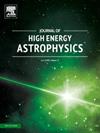Probing the warped vacuum geometry around a Kerr black hole by quasi-periodic oscillations
IF 10.2
4区 物理与天体物理
Q1 ASTRONOMY & ASTROPHYSICS
引用次数: 0
Abstract
We investigate quasi-periodic oscillations (QPOs) in the context of a new rotating black hole solution that incorporates a cosmological constant. Recent work by the authors in Ovalle (2022) interpreted the cosmological constant, denoted as Λ, as a form of vacuum energy and employed a gravitational decoupling approach to derive an extended Kerr–de Sitter black hole solution, which is geometrically richer than the classical case. In this study, we derive the expressions for timelike circular geodesics within this solution and, using a relativistic precision model, calculate the corresponding frequencies of the QPOs.
To constrain our model, we apply Bayesian formalism, utilizing data from three well-known microquasars: GRO 1655-40, XTE 1550-564, and GRS 1915+105. Our analysis reveals that Λ is degenerate and correlated with other parameters. Finally, we perform a Bayesian model comparison with the Kerr metric and find that the Kerr metric is favored among the models considered.
用准周期振荡探测克尔黑洞周围的扭曲真空几何
我们在包含宇宙学常数的新旋转黑洞方案中研究了准周期振荡(QPOs)。作者在奥瓦列(2022)中的最新研究将宇宙学常数(用Λ表示)解释为一种真空能,并采用引力解耦方法推导出了一种扩展的克尔-德-西特黑洞解,它在几何上比经典解更为丰富。在这项研究中,我们推导出了该方案中时间类圆形大地线的表达式,并利用相对论精密模型计算出了QPO的相应频率。为了约束我们的模型,我们运用了贝叶斯形式主义,利用了来自三颗著名微类星体的数据:我们运用贝叶斯形式主义,利用三颗著名微类星体的数据来约束我们的模型:GRO 1655-40、XTE 1550-564和GRS 1915+105。我们的分析表明,Λ是退化的,而且与其他参数相关。最后,我们将贝叶斯模型与克尔度量进行了比较,发现克尔度量在所考虑的模型中更受青睐。
本文章由计算机程序翻译,如有差异,请以英文原文为准。
求助全文
约1分钟内获得全文
求助全文
来源期刊

Journal of High Energy Astrophysics
Earth and Planetary Sciences-Space and Planetary Science
CiteScore
9.70
自引率
5.30%
发文量
38
审稿时长
65 days
期刊介绍:
The journal welcomes manuscripts on theoretical models, simulations, and observations of highly energetic astrophysical objects both in our Galaxy and beyond. Among those, black holes at all scales, neutron stars, pulsars and their nebula, binaries, novae and supernovae, their remnants, active galaxies, and clusters are just a few examples. The journal will consider research across the whole electromagnetic spectrum, as well as research using various messengers, such as gravitational waves or neutrinos. Effects of high-energy phenomena on cosmology and star-formation, results from dedicated surveys expanding the knowledge of extreme environments, and astrophysical implications of dark matter are also welcomed topics.
 求助内容:
求助内容: 应助结果提醒方式:
应助结果提醒方式:


